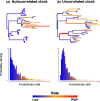Modeling Substitution Rate Evolution across Lineages and Relaxing the Molecular Clock
- PMID: 39332907
- PMCID: PMC11430275
- DOI: 10.1093/gbe/evae199
Modeling Substitution Rate Evolution across Lineages and Relaxing the Molecular Clock
Abstract
Relaxing the molecular clock using models of how substitution rates change across lineages has become essential for addressing evolutionary problems. The diversity of rate evolution models and their implementations are substantial, and studies have demonstrated their impact on divergence time estimates can be as significant as that of calibration information. In this review, we trace the development of rate evolution models from the proposal of the molecular clock concept to the development of sophisticated Bayesian and non-Bayesian methods that handle rate variation in phylogenies. We discuss the various approaches to modeling rate evolution, provide a comprehensive list of available software, and examine the challenges and advancements of the prevalent Bayesian framework, contrasting them to faster non-Bayesian methods. Lastly, we offer insights into potential advancements in the field in the era of big data.
Keywords: model comparison; molecular clock history; molecular dating; rate heterogeneity; rate models; relaxed molecular clock.
© The Author(s) 2024. Published by Oxford University Press on behalf of Society for Molecular Biology and Evolution.
Figures



Similar articles
-
Molecular-clock methods for estimating evolutionary rates and timescales.Mol Ecol. 2014 Dec;23(24):5947-65. doi: 10.1111/mec.12953. Epub 2014 Oct 30. Mol Ecol. 2014. PMID: 25290107 Review.
-
Bayesian random local clocks, or one rate to rule them all.BMC Biol. 2010 Aug 31;8:114. doi: 10.1186/1741-7007-8-114. BMC Biol. 2010. PMID: 20807414 Free PMC article.
-
Adaptive dating and fast proposals: Revisiting the phylogenetic relaxed clock model.PLoS Comput Biol. 2021 Feb 2;17(2):e1008322. doi: 10.1371/journal.pcbi.1008322. eCollection 2021 Feb. PLoS Comput Biol. 2021. PMID: 33529184 Free PMC article.
-
Bayesian Molecular Clock Dating Using Genome-Scale Datasets.Methods Mol Biol. 2019;1910:309-330. doi: 10.1007/978-1-4939-9074-0_10. Methods Mol Biol. 2019. PMID: 31278669
-
Bayesian molecular dating: opening up the black box.Biol Rev Camb Philos Soc. 2018 May;93(2):1165-1191. doi: 10.1111/brv.12390. Epub 2017 Dec 15. Biol Rev Camb Philos Soc. 2018. PMID: 29243391 Review.
Cited by
-
Challenges in Assembling the Dated Tree of Life.Genome Biol Evol. 2024 Oct 9;16(10):evae229. doi: 10.1093/gbe/evae229. Genome Biol Evol. 2024. PMID: 39475308 Free PMC article.
References
-
- Asadollahi M, Boroumand H, Mohammadi S, Mercado-Salas NF, Ahmadzadeh F. Molecular and morphological evidence reveals the presence of the tadpole shrimp Lepidurus cf. couesii (crustacea: Branchiopoda) in Iran. Zool Anz. 2023:306:1–9. 10.1016/j.jcz.2023.06.009. - DOI
Publication types
MeSH terms
Grants and funding
LinkOut - more resources
Full Text Sources

